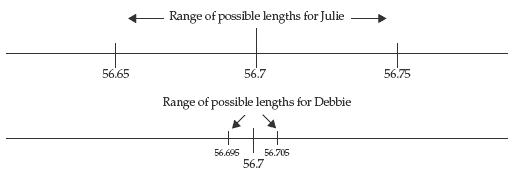Specific Learning Outcomes
Find the number of tenths, hundredths, and one–thousandths in numbers of up to three decimal places.
Description of Mathematics
Activity
Tell the students this story: “Julie has a long tape measure with divisions every tenth of a metre. She measures the length of a field and writes down 56.7 metres to the nearest tenth of a metre. Debbie measures the same field, and she says the length is 56.70 metres. How many divisions to the metre does Debbie’s tape measure have?”
The students will be tempted to think Julie and Debbie have the same answer. But the 0 shows Debbie was measuring to the nearest one-hundredth of a metre (1 cm). Draw these number lines on the board or modelling book and discuss why the 0 implies a greater degree of accuracy in the measurement. 56.7 metres represents any length between 56.65 metres and 56.75 metres. And 56.70 metres represents any length from 56.695 metres and 56.705 metres.

Repeat: Ask the students to draw number lines showing the range of possible values implied by these measurements: 45.6 millilitres, 13.567 kilograms, 1.234 seconds, 14.78 kilometres, 2.3 tonnes, 2.30 tonnes, 2.300 tonnes, 14.0 litres, 14.00 litres.
